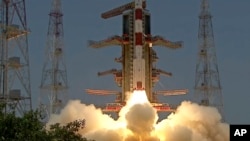India has achieved another milestone in space exploration by successfully placing a spacecraft in an orbit from which it will study the sun for five years.
India joined a select group of nations already studying the sun four months after it became the first country to land an unmanned spacecraft on the moon's southern polar region, cementing its reputation as a nation that is emerging on the frontlines of space exploration.
The Indian Space Research Organization said that the space observatory, Aditya L-1, reached the position from which it can monitor the sun’s outer layer and send data back to Earth on Saturday. The spacecraft, which was launched September 2, took four months to reach its destination.
"The orbit of Aditya-L1 spacecraft is a periodic Halo orbit which is located roughly 1.5 million km [kilometers] from earth," according to an ISRO statement.
Aditya-L1 is named after the Hindu god of the sun, called Aditya in Sanskrit. "L1" refers to Lagrange point 1, the location in space between the sun and Earth, where the satellite has been parked.
"This demonstrates India’s capability to travel over a million kilometers away from the Earth’s orbit. It is a capability that very few countries have and India is the first in Asia to do so," according to Chaitanya Giri, associate professor of environmental sciences at Flame University in Pune. "The ability to maintain deep space communication with a spacecraft that has traveled so far and sustain a mission for a long period is also significant."
The Indian mission is scheduled to study the sun for five years. The "Lagrange 1" point, where the spacecraft has been positioned provides an uninterrupted view of the sun, even during eclipses.
The major focus of the mission is to gain a better understanding of space weather, variations in the environment in space between the Earth and the sun, which is crucial for protecting satellites and other spacecraft, according to space scientists.
"It is vital to understand space weather at a time when there are thousands of satellites in space," Ajay Lele, space scientist and former senior fellow at the Manohar Parrikar Institute of Defense Studies and Analyses in New Delhi, said.
"Space weather is about disturbances that happen on the sun such as solar winds, solar flares and coronal mass ejections. These three components need to be studied," he said.
Aditya-L1 is expected to be able to give warnings about space storms that can have an impact on Earth, occasionally affecting the operation of satellites and radio communications.
The spacecraft is equipped with seven scientific instruments to study solar wind particles and magnetic fields.
Solar observatory missions have been launched so far by the U.S. space agency NASA, the European space agency, Japan and China.
India’s space program, which began in the 1960s, has gained prominence under Prime Minister Narendra Modi — it is seen as part of his efforts to promote India’s global stature.
"India creates yet another landmark. It is a testament to the relentless dedication of our scientists in realizing among the most complex and intricate space missions," Modi said in a post on X, formerly known as Twitter, on Saturday.
Other major missions planned by the Indian space agency include a manned mission to space that is due to be launched this year and an interplanetary mission to Mars.
Besides scientific space explorations such as these, India is also looking to enhance its military capabilities in space, according to experts. The first signal that it is giving a military profile to its space program came in 2019 when it conducted an anti-satellite weapon test to demonstrate that it could shoot down satellites in space — a capability that only the United States, China and Russia have.
India has plans to develop 50 new satellites based on artificial intelligence technology in the next five years to beef up the country’s border surveillance and enhance its "geo-intelligence" capabilities, Indian Space Research Organization (ISRO) chairman S. Somanath said last month.
Enhancing surveillance capabilities from space from a military perspective is key for India, according to experts. Its concerns center both on its Himalayan borders with China, where disputed borders between the two have sparked military tensions, and on the Indian Ocean region, where China has been increasing its influence.








